
There was possibly a simple Saxon Church on the present site, and it has been conjectured that the worn stone head over the main door may have been part of an earlier building, used again by the builders to look down on future worshippers as they enter God's house.
Be that as it may, it is history that the grandson of a Norman baron to whom William the Conqueror gave Barlow as a reward for his support, allotted land for the monks of Louth Park in Lincolnshire to build a church here. The remains of the Cistercian Abbey are still to be seen at Louth. We know that it was flourishing in 1139, but we have no precise date for the church building.
Apart from the church, the monks of Louth left other traces of their stay; in the name Monkwood, and also in Furnace Lane, if, as is supposed, it refers to their iron-smelting in that area. The Norman church comprised simply what is now the nave; a simple oblong.
The doorway as we have it now is probably as the monks left it, but, of course, the porch is in the Decorated style and was added much later - the 14thCentury, to protect the doorway.
About the same time, as was the custom of those days, the Barlow family added a chantry chapel to bury their dead, and for prayers to be said for their souls, it is here, for instance, that the young Robert Barlow, the first husband of Bess of Hardwick, was interred. This little chapel is known as the Lady's Quire, and during the period when it was the custom to have singers and musicians to accompany services before the organ became the only approved musical instrument in church, they built a little minstrel's gallery over it. Steps were made to it from the outside, which are still there, by the porch,and the singers struggled up the stone steps with their cellos and their fiddles and their serpents, and into the church by their own little door The door they used has long gone, which is why the steps which apparently lead nowhere are such a mystery, especially to child visitors.
Accounts paid by the churchwardens for "singers and strings" come to an end in 1846, when the church acquired a barrel organ and John Wright was brought indecorously to turn its handle as the congregation sang “All people that on earth do dwell" and similar hymns that were no doubt within the repertoire of this modern instrument !
There had been a faculty for the removal of this gallery since about 1870, but it remained until 1906. One wonders if they kept it so long because they couldn't bear to see it go, or whether the money was not forthcoming. Perhaps they harked back to the fiddles. A lovely alabaster slab memorialises Robert Barley and his wife, set here in 1938 when Sir Montague Barlow restored the family chapel, adding the oak screen. There is a painting of the slab on the nave wall nearby.
In 1784 the church was in dire need of attention, and a Brief was issued on the authority of George in for the demolition of the building and the raising of a completely new one (in those days a Brief was the authorising of money-raising for a particular object.). However, fortunately for us, not enough money came in and a patching-up job had to be done making do with absolutely necessary repairs, so that the basic shell remained intact.
Later there must have been another Brief which brought in the necessary amount, because records of 1787 tell us that "the Chappell at Barlow had a new roof on the money collected by a Brief". The churchwarden at this time was Joshua Bargh, whose name is on the bell with the date 1787. His name is also scratched in the lead of the roof of the bellcote. It was then that the first galleries were erected: the minstrels' which has already been referred to, and the west gallery, which was probably to seat the poorer folk which was the custom in those days. It was also the least costly method to increase church seating. A flat ceiling was added to the nave, which, though it must have detracted very much from the beauty of the church, may well have helped to keep it warm. It would never be allowed in our day !
The main restoration of the church came during the incumbency of George Shipton (1856-79) when a faculty was obtained to make drastic improvements The East wall, where the chancel arch now is, was taken down. Beyond it they built on the chancel and the vestry. This was carefully thought out. and they copied the chancel and sanctuary of the church at Barfreston in Kent, which was built about 1090, thus matching our Norman nave.
Again, in 1906. more work was done We have records of the Duke of Rutland being welcomed to the village by a guard of honour comprising school children,when he came to inspect the church. He agreed that the ceiling should be removed and once more the old original beams were revealed.
The oak rood screen was added in 1919 to the memory of a churchwarden from a well known Barlow family. James Shemwell, who was in office 1907-18.
The present oak gallery at the west end of the church was added in 1921. Originally the choir sat there, in the position which some say is the ideal one to lead the singing, but the organ remained rather uncomfortably in the chancel. When the organ was removed to its proper place, the oak vestry screen was given in memory of Jessie Dyson, daughter of the Vicar who had changed the traditions of the church so much. The stalls were added to match with returned stalls to save space. It was at this time of munificent giving that the Victorian tiles gave way to a wooden floor.
The pulpit was the gift of a Mr Bond, and when he died his family donated the Lychgate to his memory, designed and made by the same craftsman.
The altar, a memorial to Father Dyson, originally had four riddel posts and curtains. Eventually these were incorporated into a new reredos made by Mr.Thomas Hooker, the village joiner, making the small sanctuary appear more spacious and better proportioned.
Visitors sometimes remark on the seven sanctuary lamps. Their little lights proclaim the constant presence of God in his holy place, and remind us of the seven lamps of the Revelation to John. In particular the central lamp, the white one, should remind the noisy and the careless that our Lord is specially present in this church under the humble form of his most holy Sacrament, ready to be worshipped and adored.
Before you leave this holy spot be still for a while. Remember those who have loved it and cherished it and who have left it for us; and say a prayer for those of us who have entered into the joy and privilege of looking after it and using it.
May blessed Lawrence pray for us all and may God bless all who come here
A selection of photographs of both the exterior and
interior of our fine church are available to be viewed on our Photo
Gallery web page.
A few images relating to the text on this page are shown below.
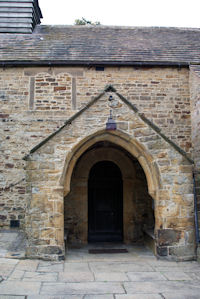
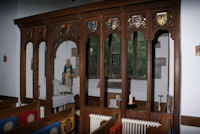
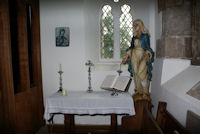
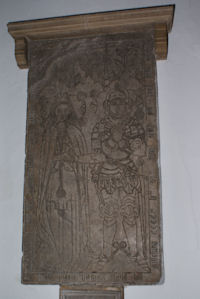
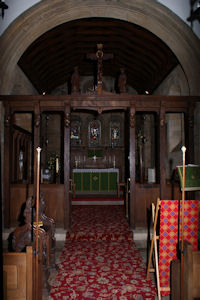

Download our Leaflet